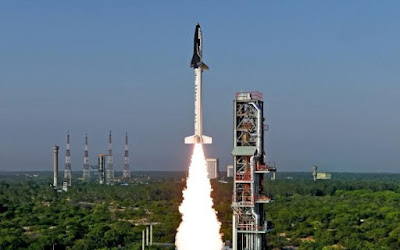First “reusable” space shuttle...................
India launched its first “reusable” space shuttle on Monday morning - albeit a one-fifth scale model of the vehicle that it hopes will one day put satellites into space at rock-bottom prices.The successful trial launch from Sriharikota, an island off the southeast coast of India, puts India’s nascent space programme in direct competition with Elon Musk’s Space X and Jeff Bezos’s Blue Origin in the field of low-cost, reusable launch vehicles.
The 11-tonne Indian prototype is claimed to have cost just one billion rupees (£10m) to develop. By comparison, Space X’s Falcon Nine rocket costs £41m to produce. Prime Minister Narendra Modi tweeted: “Launch of India's first indigenous space shuttle RLV-TD is the result of the industrious efforts of our scientists. Congrats to them.”
India president Pranab Mukherjee also sent his “hearty congratulations” to the Kerala-based team of 600 scientists who built the prototype over five years.
The Indian Space Research Organisation (ISRO) declared "mission accomplished” around 20 minutes after the 7.00am launch. The test launch saw a rocket booster propel the 21-foot long “Reusable Launch Vehicle-Technology Demonstration” (RLV-TD) model around 40 miles into orbit, before it reentered the Earth’s atmosphere at five time the speed of sound and landed safely in the Bay of Bengal.
The entire mission lasted just 770 seconds. India’s space agency aims to undercut its rivals as a low-cost option for governments and private firms seeking to put satellites and other equipment into orbit. An Indian probe launched in 2013 reached the orbit of Mars for just £50m - famously, less than the cost of the same year’s Hollywood sci-fi blockbuster Gravity (£69m).However, its reusable spacecraft is some way behind Space X and Blue Origin, with experts describing the trial as a “a very preliminary step”. This version of the shuttle prototype will not be retrieved from the ocean.
Two further prototypes will be launched before the full, 130ft-long version - highly similar in its winged design to the US’s discontinued Space Shuttle programme - is due to be launched in around 2030. Countries including Russia and Japan, as well as the EU, also have their own reusable space vehicles, at varying levels of development.Despite its relatively low cost, India’s £570m per year space programme has triggered controversy in a country where three-quarters of the population earns less than 5,000 rupees (£54) per month.
Britain ended direct financial assistance to India as of January 1, 2016, although the Department for International Development still provides support to the country through “technical assistance” schemes, such as paying the salaries of consultants working in government ministries.
According to the Indian government, DFID gave £20m for 2015-16. Direct assistance to India as recently as 2014 was £300m, official figures showed.



Comments